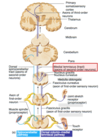20. Sensory Systems 🧠 Flashcards
(286 cards)
What receptors are responsible for the sensory modalities of touch and proprioception?
Mechanoreceptors
Describe the structure of mechanoreceptors involved in touch and proprioception.
The receptor is NOT a separate entity but is actually the peripheral terminal of the peripheral axon of the primary sensory neuron.
Describe the structure of a Pacinian corpuscle and explain how this structure relates to its function.
RA1
There is an axonal ending in the middle and it is wrapped around several concentric circles of epithelial cells – this allows the receptor to be very sensitive to vibration.

What is the difference between slow adapting and fast adapting receptors?
- Slow adapting receptors continue firing impulses for as long as the stimulus is present
- Fast adapting receptors tend to fire at the start of the stimulus and sometimes when the stimulus switches off but they tend to fade in the middle
What type of receptors are mechanoreceptors?
Mixture of slow and fast adapting receptors
Describe how sensory neurons vary in their properties.
They vary in SIZE and CONDUCTION VELOCITY
What are the two classifications of axons?
- Anatomical = based on axon diameter (labelled using LETTERS)
- A
- B
- C
- Physiological = based on conduction velocity (labelled using ROMAN NUMERALS) As axon diameter and conduction velocity are related, there is a lot of overlap in the classifications

Describe the general structure of sensory neurons that convey touch and proprioceptive information.
- They are LARGE and have a FAST conduction velocity
- Touch
- A beta (II)
- Mechanoreceptors
- A beta (II)
- Proprioception
- A alpha (Ia and 1b)
- Muscle spindle and Golgi tendon organs
- A alpha (Ia and 1b)

What is a receptive field?
An area of skin that is innervated by one sensory axon and its branches
Describe how the receptive fields in the lips and mouth vary from the receptive fields of the upper arm.
Lips and Mouth – high-density innervation with very small receptive fields Upper arm – larger receptive fields and thinner innervation
Describe how neurons can code for the intensity of a stimulus.
It is coded by the FREQUENCY of the action potentials going down the sensory fibres
Which part of the spinal cord carries sensory axons for touch and proprioception?
Dorsal columns as part of the dorsal column-medial lemniscus pathway

What are the bundles of axons within the spinal cord that have come from above and below the waist called? Describe their spatial arrangement within the spinal cord (somatosensation)
- Above the waist
- Cuneate Fasciculus
- Below the waist
- Gracile Fasciculus
- Axons from below the waist are packed more medially in the dorsal column and above the waist are more lateral
- Lower = Medial
- Higher = Lateral

Where do the cuneata and gracilis fasciuli synapse?
They synapse in the Cuneate and Gracile Nuclei in the medulla

Describe what happens after the gracile and fasciculus neurons synapse int the medulla and the tract that they run in (somatosensation)
- The second order neurons then cross the midline (decussation) where they are then known as internal arcuate fibres
- They continue up the brainstem in the medial lemniscus where they then synapse at the ventral posterolateral nucleus at the medulla now becoming third order neurones
- They then continue to the primary somatosensory cortex in the thalamus

Which thalamic nucleus is responsible for relaying somatosensory information from the neck down?
Ventral Postero-lateral
Ventral Postero-medial nucleus = face
Describe the passage of the third order sensory neuron (in the dorsal column-medial lemniscus pathway)
The third order neurone travels from the ventral postero-lateral nucleus in the thalamus to the primary somatosensory cortex
What is the main sensory nerve of the face?
Trigeminal Nerve (CN V)
Where does the trigeminal nerve enter the brainstem and where does it synapse with a second order neuron?
- Enters the braisntem at the pons
- It synapses at the trigeminal nucleus
Describe the passage of the trigeminal nerve as a second order neurone after synapsing at the trigeminal ganglion (somatosensation)
The second order neuron crosses the midline (decussation) and joins the medial part of the median lemniscus
Which thalamic nucleus is responsible for relaying sensory information from the face?
Ventral Postero-medial

What is lateral inhibition?
- Lateral inhibition takes place in the cuneate and gracile nuclei
- Each axon has lateral branches that are inhibitory on neighbouring axons
- So each axon will stimulate a second order neuron and inhibit neighboring first order neurons
What is the purpose of lateral inhibition?
Improves the resolution of localising the stimulus
Name the three parts of the somatosensory cortex.
- Primary somatosensory cortex (S1)
- Secondary somatosensory cortex (S2)
- Posterior parietal cortex












